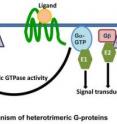Discovery identifies elaborate G-protein network in plants
The most elaborate heterotrimeric G-protein network known to date in the plant kingdom has been identified by Dr. Sona Pandey, principal investigator at the Danforth Plant Science Center. The results of this research are published in the recent article, "An elaborate heterotirmeric G-protein family from soybean expands the diversity of G-protein networks," in the New Phytologist. G-proteins are signaling proteins that direct a plant's response to various environmental signals including abiotic and biotic stresses such as drought and disease resistance. Prior to Dr. Pandey's discovery, it was assumed that plants had only one Ga protein based on previous research using Arabidopsis and rice, in contrast to 23 Ga proteins present in humans. Using soybean, Dr. Pandey's group was able to identify four Ga proteins. In addition, they demonstrated that two of these proteins can react faster than was previously assumed.
Mammals have many G-proteins. These proteins bind GTP (small molecules) and hydrolyze it to GDP. The G-proteins are active only when GTP bound. Binding is a key process because that is when the signaling can occur. Mammals' G-proteins are very quick to hydrolyze bound GTP and thus cycle fast between the GDP bound and GTP bound states. The sole Ga protein of the model plant Arabidopsis is very slow to hydrolyze bound GTP. In this research Dr. Pandey's group also demonstrated that soybean has two types of G-proteins, two that hydrolyze GTP slowly and two that work more quickly similar to those found in mammals.
"The next step will be to try and engineer plants to express altered amounts of these G-proteins to see how they affect their overall growth and can enable them to better respond to stresses that may be involved in limiting crop yield," Pandey said.
Source: Donald Danforth Plant Science Center
Other sources
- Discovery identifies elaborate G-protein network in plantsfrom Science DailyFri, 22 Apr 2011, 2:30:22 UTC
- Discovery identifies elaborate G-protein network in plantsfrom PhysorgThu, 21 Apr 2011, 14:31:20 UTC
- Discovery identifies elaborate G-protein network in plantsfrom Science BlogThu, 21 Apr 2011, 14:00:35 UTC
